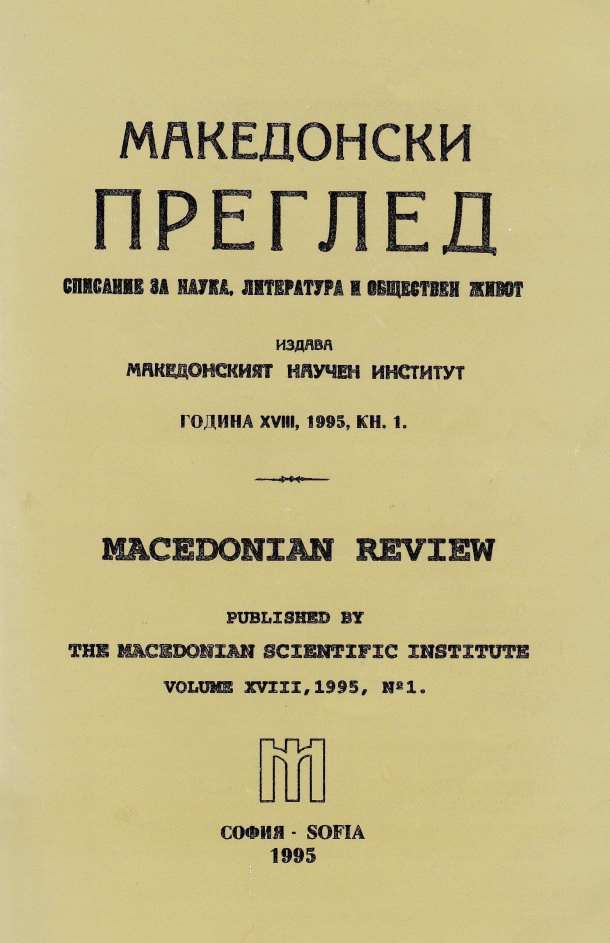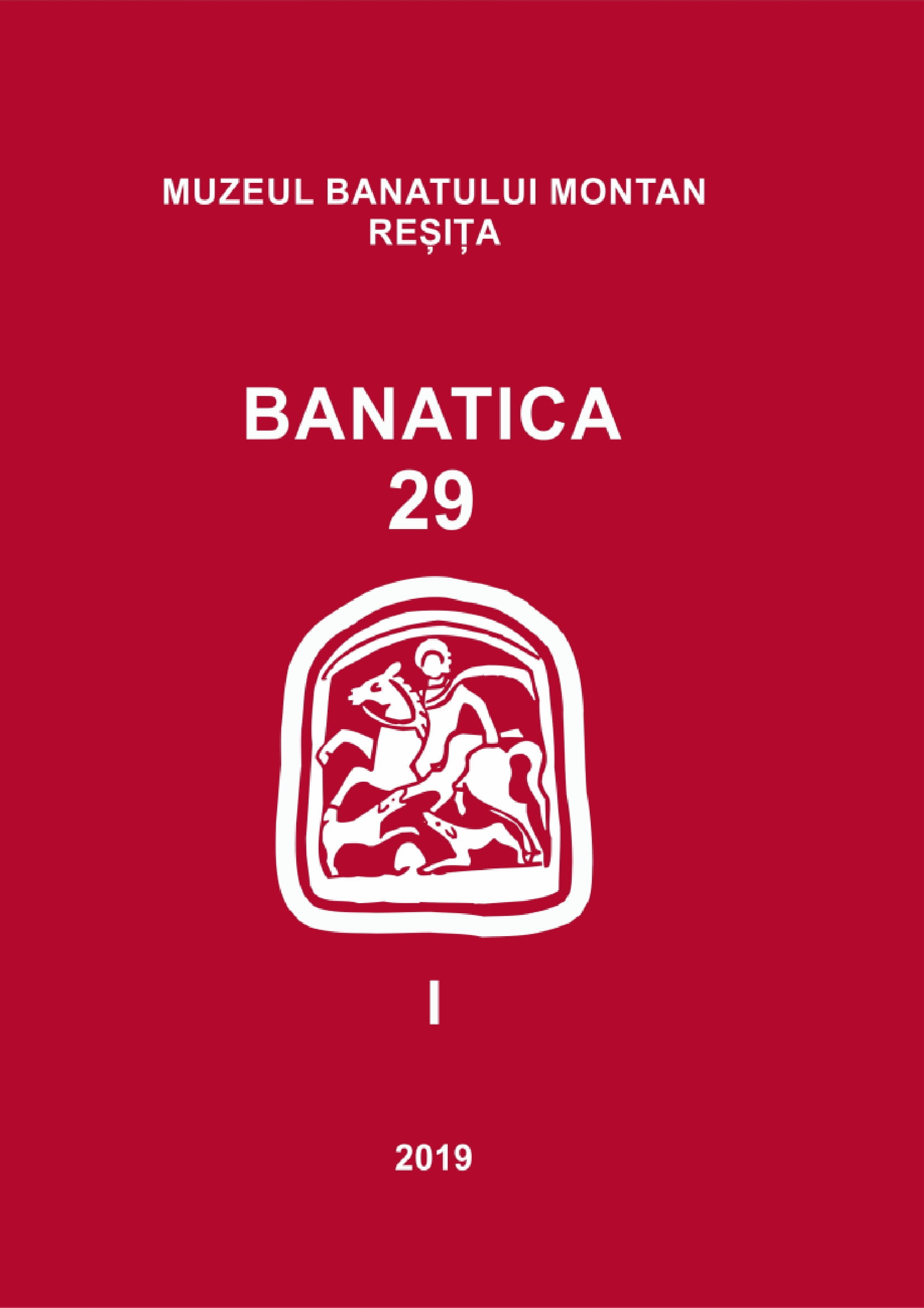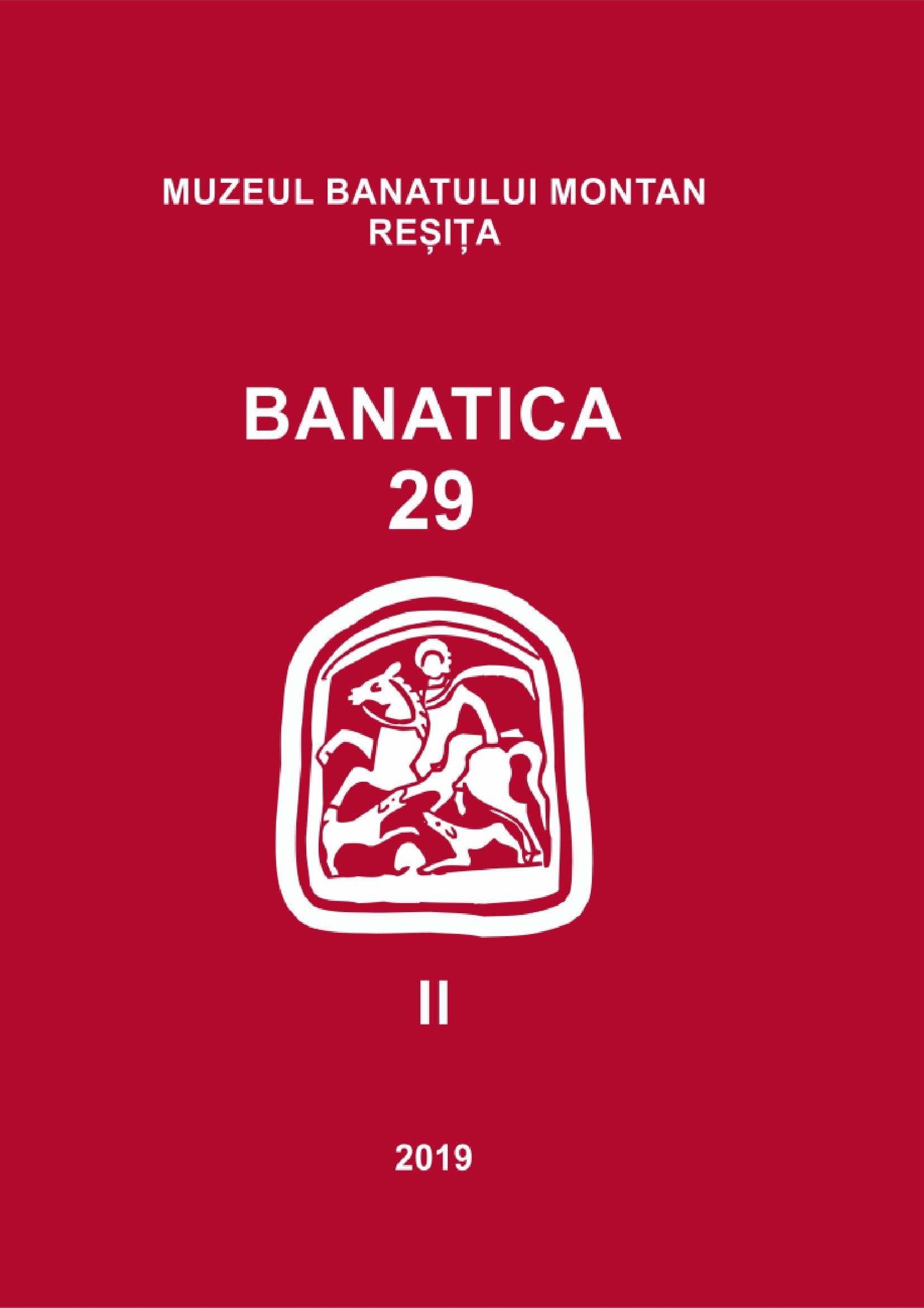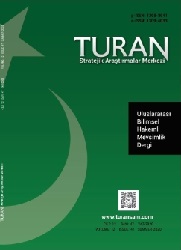
We kindly inform you that, as long as the subject affiliation of our 300.000+ articles is in progress, you might get unsufficient or no results on your third level or second level search. In this case, please broaden your search criteria.



Bodrog County is one of the tragic fate counties of the Kingdom of Hungary. Its history is typical, its medieval population and settlement network were almost completely destroyed in the 16th century, and most of its medieval resources disappeared. For this reason, the historical geographic research of Bodrog County is a major challenge. The aim of my research is to reconstruct the medieval settlement network of Bodrog County; to summarize the general history of Bodrog County, with special regard to the medieval and early modern administration and the changes in the settlement boundaries. This multidisciplinary research is based on written, pictorial and field-based archaeological, ethnographic, historical and geographical data.The most important element of the research is a GIS system developed for geographical settlement modeling, in which literature and field data are used; furthermore various remote sensing and map data were summarized and evaluated. Another unique methodological element of the research is the socalled “social archeology”, which provided a wealth of data during intensive archaeological field research. The fact that Bodrog County is located partly in the southern part of present-day Hungary and in the northern part of present-day Serbia has made the research more difficult. The size of the county changed several times during it’s slightly more than five-centuries-long existence. Between the 11th and 13th centuries, its area stretched from the Danube to the Tisza River in an east-west direction, and from the present Kiskunhalas in the north to Verbász (Vrbas, Serbia) and Szenttamás (Srbobran, Serbia) in Bačka in the south. The result of this research is a database of medieval settlements in Bodrog County, including maps and aerial imagery available from archaeological research and the literature to the present day. Simultaneously, the development of a printed and online database of the collected data has begun. The primary purpose is to make this database available to professionals and civil users. The research has revealed that many of the written sources of Bodrog County have been lost over time. However, compared to the surrounding counties, there are many medieval documents that contain a lot of useful geographical data suitable for settlement modeling.
More...
The Gârleștenis of Rudăria made a special figure among the Romanian noble families in the medieval and pre-modern Banat due to their almost permanent connection to the local centers of power. During one century and a half, from the end of the 15th century up to 1658, 7 members of the family hold some of the highest dignities in the Banat of Severin, and the Banat of Caransebeș and Lugoj after: bans of Severin, vice-counts/ castellans in the county of Severin, and prime-judges (mayors) in Caransebeș. It is but an interesting model of social ascension and perpetuation of the political influence based both on a series of remarkable personalities in the family, and the weal they inherited or provided by exerting their functions in the course of time. The present study follows the history of the family during the Principality of Transylvania age, by dwelling on the aspects of male and female right of succession, legacies or transactions the members of that family operated, or the inherent litigates before the courts of that time. The study comes as a necessary completion of my previous studies on that so influent family in the Banat, in the days of yore.
More...
At the end of the 16th century, in the context of the Long War between the Ottomans and Habsburgs, the territory of Timiş County (nowadays Banat) was the subject of disputes between Christian and Turkish troops. The Transylvanian armies occupied a number of territories on the Mureş valley and nearby Timişoara, areas where nobles from the Principality received various donations. The territorial impact of Christian recoveries can be noticed by following these donations of Transylvanian princes. The Mureş Valley, a strategic route for the Transylvanian Principality, was almost entirely recovered. Although Timişoara could not be conquered, the Transylvanians imposed themselves on the west, south and north of the city by occupying some villages only a few kilometres from the city gates. The documents published in this study offer us the opportunity to investigate the social, military, political and economical framework of the province between Mureş, Danube and Tisza Rivers in the early modern times.
More...
The outbreak of the Romanian uprising in Transylvania in the late autumn of 1784 caused, as might be expected, the interest of the press in the Habsburg Empire as well as abroad. Aside the officious “Wiener Zeitung” published since 1704, the journals from Pressburg/Bratislava (“Pressburger Zeitung”, “Presspurské Nowiny” and “A Magyar Hirmondó”) but especially the “Siebenbürger Zeitung”, issued in Hermannstadt/Sibiu since January 1, 1784, in the neighborhood of the uprisings scene, were the main sources of news for readers in and outside the Habsburg State. Being under a strict surveillance by the state authorities, even though the censorship was officially abolished in 1781, these journals offered only dry reports on the ongoing uprising, without any free expression of their opinions, except “A Magyar Hirmondó”, imbued by an open sympathy towards the Hungarian nobility and a large disregard towards the Romanian population. At the same time, the readers in Vienna had the opportunity to find various reports on the Romanian uprising in the issues of “Provinzialnachrichten”, a journal with two weekly editions (Wednesday and Saturday) published from July 2, 1782 to June 27, 1789 by the official Courtprinter and editor Johann Thomas Edler von Trattner. Since November 1, 1783 “Provinzialnachrichten” was led by Johann Friedrich Schmidt, a free-mason (member of the Illuminati Order), employed until then by the “Wiener Zeitung”. It is to be pointed out that, whereas the “Wiener Zeitung” published only nine reports on Horea’s uprising, “Provinzialnachrichten” offered to its readers no less than 25 pieces of news related to the ongoing events (published in the Appendix). All reports issued by the “Provinzialnachrichten” were taken, word by word, especially from the “Siebenbürger Zeitung” (14, i.e. 56%) and the “Wiener Zeitung” (4, i.e. 16%), while seven reports (i.e. 28%) could not have their sources established. Only in very few situations the “Provinzialnachrichten” added personal comments, this especially to deny various false news published by other journals (e.g. that Horea had managed to escape from prison in Alba Iulia/Karlsburg seeking and finding refuge in Wallachia). Even when such false reports supported official opinions (e.g. that, during the disarmament of the Romanian peasants after the uprising, several Turkish rifles were found in their possession, suggesting a Turkish involvement and support in favor of the uprising in Transylvania), “Provinzialnachrichten” willingly published the news. However, at the same time, “Provinzialnachrichten” offered to the cautious and attentive reader in Vienna the opportunity to seize and understand the actual social and national aims of the Romanians in Transylvania during their uprising in 1784.
More...
The district of Baia Mare, located in the eastern area of Satu Mare County, includes all the shapes of relief (mountains, hills, plain) and this is a fact to leave mark upon the population’s life and evolution. The largest number of localities is located along the valleys that dig the territory, the Someș Valley especially. The Depression of Oaș and this one of Maramureș are also intensely populated, with a high number of localities. Apa and Medieșu Aurit are to be noted for their highest demographic density, in the area of the Someș Valley, a proper place for agriculture and for a better living standard so. Mining was the occupational filed for many of the district’s habitants, especially for those in the mountainous areas of Oaș and Baia Mare, and Baia Sprie countryside, together with breeding and farming. The mining workers’ life was particularly difficult. The privileged statutes of the two towns mentioned above proves the mining ampleness and importance in this district which was the unique territorial-administrative unit to include two royal free towns in the county of Satu Mare.
More...
Hygiene was one of the important items of the lot of emancipation factories, which runs in Timișoara daily life within the interwar period. Hygiene, coming from the Greek name of Hygieia, Asclepius’ daughter, the medicine god, means the series of conditions and practices that constantly maintain health.Auxiliary based on hygiene, the field of beauty making contributed to identify and promote the cult of exterior image, through advertising, like a real industry.The advertising message was built to leave the potential client see only the qualities of the product not its deficiencies. The advertising in interwar period might be the ideal of the great corporations of today, with the advertising to say all, leaving no space for interpretations and totally directing the product toward the consumer. Timișoara re-found its former social-economical identity after I World War. So, the territorial-political liberation brought in its train a spiritual-creative releasing able to forecast an almost total daily life bold re-initializing. The hypothesis of modernizing took place within the society in Timișoara, generated by a social metamorphosis and mental changing which is mainly put in light by the young inhabitants who adopted the stylistic trends of the developed Western Europe.The beauty industry’s model transposes the contemporary women’s look in shapes tacitly going from natural to artificial. The women’s natural beauty came so to be falsified by fashion products and those ones generated an artificial beautification due to need of opening a large market for colors, cold creams, lipsticks, and mascara.
More...
The present study aims to analyze the relations between the political decisional factors and press in Timișoara, in the 1970s. There were the following papers in Timișoara between 1970 and 1977: Drapelul roșu, Neue Banater Zeitung (German language), Szabad Szo (Magyar language), Banatske Novine (magazine, Serbian language), and the literary revue Orizont, all of them with an important circulation. The local Radio studio was also running then.Even if the years of 1965–1971 are better known as providing a relative political freedom, press in Romania went away with the RCP control; relations between the party and media deeply changed in the summer and fall of 1971, after the decisions taken by the leaders of the R. C. P. So, media was obliged both to put in light the socialist reality in Romania and to combat with the ideological bourgeois influences and retrograde mentality. The cultural revues had to promote the “involved” militant socialist arts and literature, and criticize the tendencies to separate the artistic creation from the socialist realities; it was the way the Romanian press became an instrument of the RCP. The journalist’ rules were changed too, so that one became a Party activist in that occupational field. Following the above decisions media in Timișoara was controlled by the Section of Propaganda, the Secretariate, and the County Chancery of the RCP; all those organisms periodically analyzed the activity of journals, revues and the territorial Radio Studio.1974 was also an important but baleful year for Romanian media due to the central decisions to reduce copies, formats, numbers of pages, and periodicity of journals; all those measures touched the press in Timișoara too (Banatske Novine – for instance)Media in Timișoara had mainly to emphasize at that time the activity of the county Party organization, and the political, economical, social and cultural-scientific life in the county. The county authorities attracted the journalists’ attention on the necessity to strengthen the Party militant spirit of all the articles and broadcastings as they considered that trite expressions still were published in articles with a strong formalist shape. The analyses also underlined that there was no clear position both against reactionary philosophic or aesthetic schools and political Occidental doctrines, the capitalist “drawbacks” being so not sufficiently presented. Such critical observations make us believe that the journalists in Timișoara didn’t comply integrally with the “ideological orders” of the Party.But we have also to note that besides those “political commands”, there were some positive measures taken by the RCP County Committee: a more extensive mirroring of the culture in the Banat, or of important moments of the history of the Banat and Romania. The communist authorities were also concerned with the future journalists’ professional training, as long as there were still unschooled journalists at the beginning of the 1970s. I have to observe that the professional vocation of the ones who applied for was taken into consideration besides the negative aspects – need of a “healthy” political origin, the candidates’ deeds severe political examination or recruiting the candidates from the workers’ class especially.
More...
Osvrt na znanstveni skup Splitski gradonačelnici od pohrvaćenja splitske Općine do kraja Prvoga svjetskog rata (1882.-1918.) održanom 8. svibnja 2018. u Muzeju grada Splita.
More...
For centuries, Azerbaijani Turks or Karapapaks have been densely settled in the city of Tbilisi, the capital of Georgia, and the surrounding regions of Borchali and Karayazi. These Turks, whose number has reached 500 thousand today, continue their existence in the geography of Georgia and continue their religious-cultural traditions. In particular, they observe the legal rules of the country, maintain their religious customs and perform their religious practices. With this fact in mind, the purpose of this article is to illuminate the Muharram Shahsey Vahsey mourning ceremonies that have been performed by Turks in Georgia for centuries. It focuses on condolence, ashure rituals and ceremonies, which have an important place in the religious folk tradition of Muslim Turks. The subject is limited to the city of Tbilisi and the second half of the 19th to early 20th centuries. As primary sources, the relevant articles in the 19th century Tbilisi's Russian and Georgian newspapers and the memories of early 20th century artists are handled.
More...
In this article studies the German colonial heritage in the town of Goy-Gol. In the research paper being considered to review the historical development of the Helenendorf settlement which is now known as the town of Goy-Gol. This research article is studied the settlement a particularly what was emerged and in which historical period shaping from the viewpoint of architecture, town-planning. In this case study the structures that are the cultural architectural heritage of town are elucidated on the basis of which typology and who designed by. There is carried out classification of architectural structures that are built in the historical Helenendorf. A certain way are considered to review by defining the types of structures on their characteristic features in a typologically. The situation of these structures in the town-planning system and the historic Helenendorf's general urban design nature were studied. Thus, the cultural heritage of Helenendorf, until now which has been researched from a historical and ethnographic viewpoint, also in there now studied by the authors from the architectural-urban aspect.
More...
Vicko Josip, Juraj Mihaljević and Domina Dujmović’s son, was born in Split on April 5th 1861. He finished both elementary and grammar school in Split and graduated from law school in Graz. After he returned to Split in 1884, he became active in politics. In the following year, however, he was offered a secretarial post in the Split Municipality by Gajo Bulat. He resigned from this post in 1891 to apply for the bar exam and start practising law. He married Tereza Lovrić in 1898, who was the daughter of tradesman Pavle Lovrić and Ana Školjan. As a politican, he supported and eventually joined the new Party of Rights whose chairman was Ante Trumbić. Vicko Mihaljević left his mark in the Croatian literature as a poet. He published poetry under the pseudonym of Neurastenicus. He created a number of humorous and patriotic poems, that, in 1900, were published in the two collections: Na uztuk and Pregršt šušnja. V. Mihaljević was a representative in the Diet of Dalmatia. He was also a manager of a number of firms and head of the Split branch of Ljubljanska banka. He was at the helm of various associations, such as Hrvatski dom (Croatian Lodge) and Za Split (For Split). In addition, he was a board member of the so-called Hrvatski sokol and participated in board elections for association Bihać. He was a man of many hats – although a lawyer, he was interested in mining and crafts. He was appointed Mayor on 11th June 1907. He held office for four years, that is, until sudden death. Many positive changes occured in the course of his tenure. Public roads in both the central and greater area of Split were constructed; school buildings were built and for that very purpose, the Municipality either acquired or rented plots of land. The construction of the Croatian Lodge was completed in January 1908. Since its main hall was yet to be completed, a charity ball was held in the Theatre to raise funds for its construction. Finally, the hall was opened on 13th September, in the presence of many distinguished guests, such as the mayor himself, Frane Bulić, et al. He died of stroke at home, at the age of 50, on 25th June 1911. He was buried three days later at Sustipan cemetery. A renowned sculptor, Ivan Rendić, designed his tombstone – an allegorical sculpture named Meditation. The citizens of Split were shocked by the sudden death of the mayor and thus decided to arrange a majestic funeral. The article published in his honour in the newspaper Naše jedinstvo read: Dr V. Mihaljević lived for his people and his town. He is therefore mourned today and will be mourned wherever there are those who had honour to know him and wherever there are Croatians. May God bless his soul! However, in the following year, in the section Gradski vjesnik of the same newspaper, the article was published that read: It has been a year since our dear mayor, Dr Vice Mihaljević, passed away, but noone seems to remeber him anymore. His wife Tereza inherited both his assets and liabilities.
More...
Vinko Katalinić played a significant role in the political and socio-economic life of Split in the late 19th and the early 20th centuries. He worked for Assicurazioni generali. At the same time he was the president of both the local branch of Ljubljanska banka and the Croatian Worker Cooperative. In addition, he was the Kingdom of Greece Consul and one of the founders of Hrvatski sokol. He was particularly active in promoting the necessity of the construction of the Croatian Lodge. Vinko Katalinić became more politically active when he joined the Croatian People’s Party. In the period 1897 – 1911, he was the assessor of the Split City Council. He was elected Mayor of Split on 28 December 1911. His mayoral tenure ended on 16 November 1912. On that same day, the City Council was dissolved. Since he participated in the rally in support of the Kingdom of Serbia and Montenegro in the Balkan Wars, the Austrian authorities filed a lawsuit against him. However, he was acquitted of charges by the court in Klagenfurt on 1st May 1914. In early 1913, after local elections, Vinko Katalinić became mayor once again. The tenure was rather short: it ended on 16 August 1914, after the dissolution of the City Council. Vinko Katalinić died suddenly on 11 May 1917 at 60 years of age. Two days after, a large public funeral was held in honour of the much-admired mayor.
More...
At the very end of the Second Austrian Administration (1814 – 1918), town commissioners were appointed to serve as mayors. Teodor Šporn was one of them and he was appointed twice. His first appointment was for the period 16 November 1912 – 26 March 1913, and the second one for the period 22 December 1917 – November 1918. His tenure was not long and, therefore, there were not many significant changes that he could introduce. However, the historical circumstances under which he served were significant and the end of his tenure marked the beginning of a new stage in the life of the city. Teodor Šporn was born in Škofja Loka in 1879 and died in Ljubljana in 1953. He graduated from grammar school in Sušak. He worked as an Austro-Hungarian civil servant in Zadar (1902), Split and Benkovac (1915). After the Great War, he served in the National Council of SCS as a councillor representing Slovenia and as an advisor to Deželna vlada za Slovenijo (Slovenian Public Government). As an advisor, he played a significant role in the Carinthian plebiscite. Teodor Šporn was a typical Austro-Hungarian bureaucrat. He served as a civil servant in cities around Dalmatia in the turbulent period of history marked by the Balkan Wars, the Great War and the dissolution of the Municipality. In light of all the events, town commissioner Teodor Šporn, together with all other Slovenians who actively participated in the Split life, left a significant mark in its history.
More...
Dr Frane Madirazza was a significant figure in Trogir at the turn of the 19th century. He was both a highly positioned civil servant and a prominent intellectual with a vivid interest in the history of his homeland. During his long and fruitful career, he worked in several Dalmatian towns as a highly positioned civil servant: in Knin, Šibenik and Split he was appointed head of the district. On 16th August 1914, that is immediately after the outbreak of the Great War, the City Council was dissolved. The dissolution order was issued by the Governor’s office. After reaching agreement with the National Committee of the Kingdom of Dalmatia, the Authorities appointed Frane Madirazza as Municipal Administrator. The citizens approved of his appointment, since he was known as an expert in administration with a clear vision for the future of the city. He stated that his focus would be on public order and safety, public health and a regular food supply. The Municipality was in financial difficulties and he worked hard to lessen the negative effects. He managed to maintain the authority of the local council in relation to a large number of local issues. Madirazza was also a fervent advocate of the Croatian identity of the Municipality. He informed the public about military successes and encouraged the citizens to decorate the city with both the state and national flags. Madirazza’s main preoccupation, however, in those years of deprivation was of a humanitarian character. To help war veterans through the rehabilitation process, he organized courses in Trade school. He granted financial aid to the families whose members were soldiers on the front lines and made the decisions about the distribution of the rationed food supplies to the citizens. He remained in office until October 1917, when he was reinstated in civil service as the head of the district in Knin. Madirazza left office in Split on 25 November 1917 and departed straightaway. He would be remembered as a man of integrity.
More...
Vicko Niseteo (1857 – 1939) was a descendant of a distinguished family from Stari Grad on the island of Hvar. He graduated from law school in Graz where he, several years later, also obtained his doctorate degree. In 1882, he opened his own law practice in Stari Grad. The same year marked the start of his political engagement in the national revival. In 1887, he was appointed assessor of the Municipality. He remained in office until 1892. That was the year of major disagreements within People’s Party in Stari Grad that resulted in schism, which was provoked by the establishment of the so-called Croatian group within the Diet of Dalmatia. Vicko Niseteo moved to Split in 1908, where he opened his law practice. In addition, he was a co-founder and president of the Split Bar Association. In 1917, he was appointed municipal administrator. His tenure was rather short – it lasted for a month. Vicko Niseteo died in Split in 1939.
More...
To the extent of our knowledge, it was an archivist from Zadar, Šime Peričić, who, fifty years ago, was the first to address the role of consuls in Dalmatia. Therefore we believe that the significance and role of consuls in Split during the second Austrian administration should be given more attention. Foreign consular offices were established in both Split and Dalmatia during Venetian, French and Austrian administrations. Several consular offices were reestablished during the Congress of Vienna, that is, after Austria had annexed Dalmatia. Austrija was against establishing foreign consular offices in its ports at first, but then consented to it. The Kingdom of the two Sicilies was the first to establish the office in Split. The consular agent of the Kingdom of Naples, Domenico Castoldi, was granted permission to resume his consular activities in Split in the early 1814. Two other states on the Apennine Peninsula, Papal State and the Duchy of Parma, had their respective offices in Split. Greece, France, Germany, Sweden, Norway, Belgium and Uruguay established their consular offices in Split, as well. As representatives of Italy, consuls of exclusively Italian origin with extensive experience in diplomacy were assigned the office. As for the representatives of other states, they were elected among local citizens. Those were usually renowned individuals who were active either in political or social lives of their communities. In Split, those were notable wholesalers and politicians, who supported either the People’s Party or the Autonomist Party. Having used a number of available resources, the authors have attempted to analyse the involvement of consuls in various associations and in the economic life of the city. The analysis is, however, incomplete, since the information on all the consuls and their activities is rather scarce. Yet, the authors have managed to establish that the majority of consuls in Split originated from the Katalinić and the Jeličić families.
More...
Jerko Čulić (1898 – 1953) played a significant role in the economic, political and social life of Split in the first half of the 20th century. Having been born in a deprived suburb, his interest in politics, that he developed in his early adulthood, revolved around the central idea of the time – the unity of the Southern Slavs. His disdain for the Monarchy reflected in a number of writings and agitation attempts, which eventually resulted in incarceration. After the war, he became involved in social politics and humanitarian work. His attention eventually shifted towards tourism industry: he achieved immense success having initiated and established organised tourism in former Yugoslavia. He was also the first chief executive of the Split branch of Putnik, which, at the time, was a state tourism agency. Jerko Čulić was a prolific author of brochures and travel books. He regularly published a large number of travel magazines and thus contributed to the promotion of the Croatian Adriatic and his native Dalmatia. Due to his cooperation with the so-called Društvo za za uređenje i proljepšanje Bačvica i Firula (Bačvice and Firule garden design improvement association) his influence is still visible in the horticultural layout of the eastern waterfront in Split. He was married to a teacher and a political and humanitarian activist, Maja Čulić, with whom he had four children.
More...
The review of: Nenad CAMBI: Dioklecijan: vir prudens, moratus callide et subtilis ili inventor scelerum et machinator omnium malorum. Povijesne kontroverze i današnje dileme / Diocletian: vir prudens, moratus callide et subtilis or inventor scelerum et machinator omnium malorum. Historical controversies and current dilemmas (Split: Književni krug i Filozoski fakultet Sveučilišta u Splitu, 2016.). 315 str. ISBN 978-953-163-429-8 (KKS).
More...